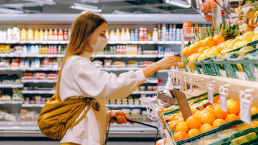
Why is World Food Safety Day 2021 Important?
For World Food Safety Day 2021, we explore the importance of the topic and speak to Dr Antonio Lourenco, Guest Editor on a Special Issue, about his work.
What constitutes food safety?
We don’t often see the rigorous processes that go into ensuring that our food is safe for consumption. Before it reaches our kitchen tables, our meals undergo specific, regulated practices during all stages of the food supply chain, including the growth, transport, preparation, and serving of food products. A lack of these precautions means that foodborne diseases, as a consequence of bacteria, viruses, parasites, chemicals, and toxins, will be able to thrive, to the detriment of our physical and economic health. However, the onus to facilitate and maintain the safety of our food is on us all—from consumers to producers to governments.
What is Food Safety Day?
Food Safety Day will be celebrated for the third time ever on 7th June 2021. Its purpose is to establish the recognition of the burden of foodborne illnesses within the population in the hope of their reduction. If successful, this will enable foodborne contaminants and hazards to be identified at their source and, consequently, prevented. Food safety is crucial for the health of the population, the economy, and Earth.
The World Health Organization (WHO) and the Food and Agriculture Organization of the United Nations (FAO) have estimated that approximately 600 million people become ill, with 420,000 cases resulting in death, every year due to consuming contaminated food, and thus have identified five calls to action to tackle this avoidable suffering:
- Ensure it’s safe, which calls upon governments to guarantee food safety for everyone;
- Grow it safe, which expresses the necessity of farmers and food producers to implement standardised safety processes;
- Keep it safe, which outlines the need for business operators further down the chain to ensure food safety;
- Know what’s safe, which encourages consumers to educate themselves on what constitutes safe and healthy food consumption;
- Team up for food safety, which highlights the need for global collaboration to work towards safe and healthy food consumption for all.
The WHO and FAO have produced a helpful and easy-to-understand guide outlining the details of their campaign and further elucidating the pivotal reasons behind the drive for worldwide food safety and how you can play your part.
Who is Most Affected by Poor Food Security and Safety?
Food security and safety go hand in hand; one cannot exist without the other. The World Health Organization (WHO) states that “If it is not safe, it is not food”, as it does not serve its purpose to provide proper and safe nutrition. This has the strongest impact on the poor and the young, as well as those living in low-income countries, who may not have access to safe and healthy food and water, creating a huge socio-economic issue in need of urgent attention.
Food Safety and COVID-19
As published evidence points to SARS-CoV-2 having a zoonotic origin, our awareness of farm-to-fork virus transmission has become heightened, and a sense of panic and blame has been spread. It is through education and cooperation that we must all lend a hand in implementing preventative quality control measures to combat foodborne illnesses, thus avoiding future pandemics and, in turn, preventable deaths.
Food Safety and MDPI
MDPI’s journal Foods seeks to create a platform for all professionals within the food industry to share their discoveries and expertise regarding all aspects of food, in order to disseminate this knowledge to as many readers as possible, thus enabling progression within this all-important domain. One specific section of the journal is dedicated to Food Safety and Food Security, which has published 498 papers to date and concerns the effects of various food properties on quality and safety. Among the Special Issues comprising this section is “Foodborne Pathogens and Food Safety”, of which Dr Antonio Lourenco is one of three Guest Editors and among the many people helping to make progression in this field possible.
What has your time as GE of this Special Issue taught you about your field?

Dr Lourenco: My time as GE for the Special Issue of “Foodborne Pathogens and Food Safety” in the journal Foods has shown me a global effort to improve the understanding of foodborne pathogens and their interaction with their food matrices. It has taught me about the importance of quality peer review that not only checks if a manuscript conforms with the current knowledge in the field but most importantly checks if the scientific knowledge being created is sound.
What do you perceive as the most important developments in your field in the near future/what current developments will have an impact on your field in the near future?
Dr Lourenco: Currently, there is a great emphasis on new food sources that range from algae of fresh water and marine origin to plants and insects. Also, these new food sources will have to undergo novel or adjusted food processing technologies. This will require deep research to understand the microbiological hazards and associated risks involved.
The Special Issue “Foodborne Pathogens and Food Safety” is currently online and welcoming submissions.
World Food Safety Day and more
We have plenty more interviews available on the Blog, click here to read more.










